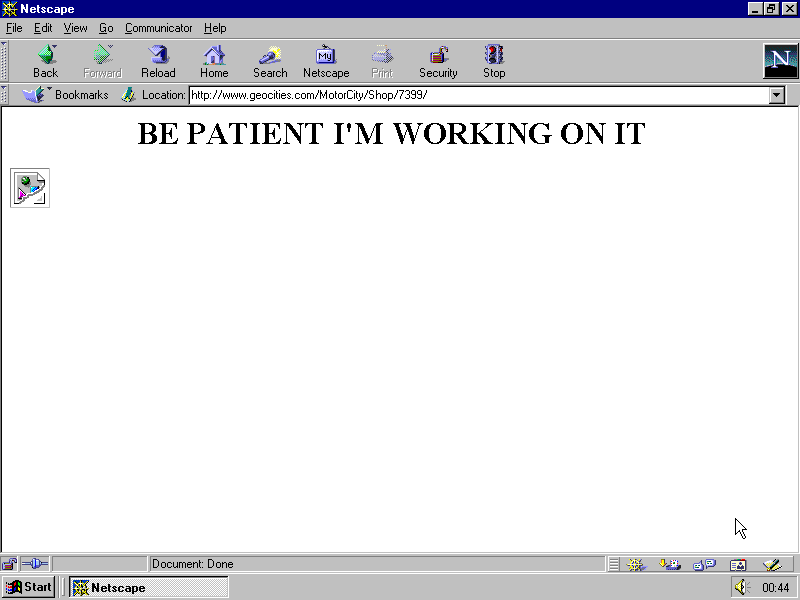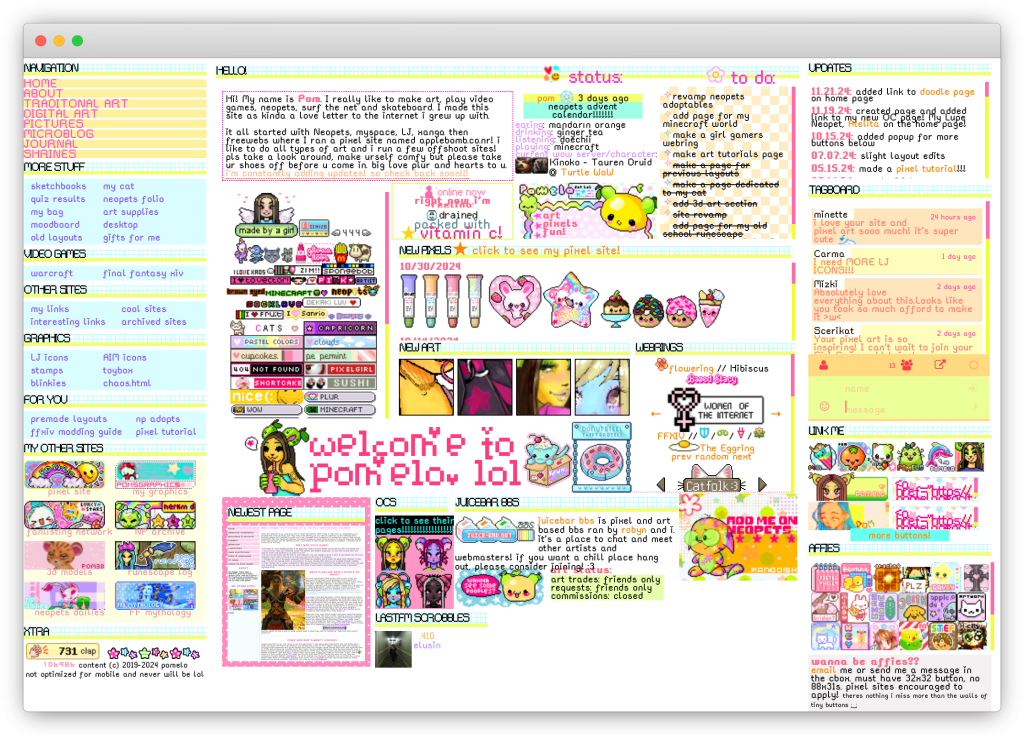
see more Give me time/This page is no more
As I’m toiling through Derrida and archives and memory and fictocriticism – and everything that comes along with such slippery and messy concepts – I slipped into a rabbit hole thinking I could be able to resurface the web community I was part of from 2009 onwards and see what I could uncover…

I see few contemporary stylistic continuations today of these types of websites that I used to spend my teens making, consuming, and browsing. This ensued in my getting very lost and deeply swept into the culture. And of course, I was around when Geocities was around too. My friend’s first website when they made theirs about Runescape looked so cool to me. I could only do a shoddy one at that point. Frenzied with jealousy, I somehow caught up by manic, obsessive HTML learning (foreshadowing a bipolar disorder that would emerge around 9 years later) and built a lovely site with a pink background to commemorate our friendship group a week later.
After that, I somehow slipped my way into the pixel culture side of the internet that I’m not actually sure if normal people remember. Pom’s Pixels is a great example of this kind of internet.

So now that my internet beginnings are slightly expounded on, I think there’s a 1) anti-establishmentarianism and 2) community of care and comfort that these origins had sowed in me. There’s this certain GeoCities → Pixel website creator → Web 1.0 overlord → Suddenly Web 2.0 comes and we panic → WordPress tinkerer that learns PHP → Somehow gets radicalised by GNU/FOSS/Copyleft → Marxist → ??? pipeline.
So I’m just about to go into the Marxist part of it all and I am starting to educate myself on a large chunk of web history that I was not aware of (because architecture school got in the way). I’ve been looking at solarpunk philosophies of web design, the Web Design as Architecture manifesto, Jaap Bakema Study Centre’s Repositioning Architecture in the Digital, but something seemed quite hard to pinpoint: which was the pipeline in blue above.
I tried looking for more radical approaches to the internet in the times between Web 1.0 and Web 2.0, just to see if I could see any remnants, traces, or fragments of the GeoCities/pixel art culture in its documentation. My hypothesis would be that GeoCities/pixel art culture and its decentralised, independent, authentic approach to the creation of knowledge generated an audience who would be more susceptible to being sympathetic to the left, and harbouring a sensitivity to marginalised discourses.
And this all ties in nicely with the issue surrounding traditional institutional physical archives silencing marginalised discourses with ease. With digital archives, it is a little easier to give instead of silence voices. It’s not completely perfect at doing that, far from it in fact, but it’s a good start. To restrict access to records is to exercise archival power – I’m starting to see a little how the static, decentralised Web 1.0 would be more amenable to a radical reading of internet history. Of course, I’ll not go into the Derridean ramble about the word archive, or how digital archives have completely altered the conceptualisation of archives and archival practice. I’m sleepy and just want to sleep.
My search didn’t bring me many answers, as expected. But it did give me a lot to read about, which I will share with you in the form of a list.
- ‘₊˚⊹♡ Pom’s Pixels V.5 Rainy Bows ₊˚⊹♡’. Accessed 8 December 2024. https://pomelo.lol/pixel/home.
- ‘FRESH SELECT’. Accessed 8 December 2024. https://pomelo.lol/.
- Lialina, Olia. ‘TOP TEN GEOCITIES SCREENSHOTS 2013 – 2023’. One Terabyte of Kilobyte Age (blog), 16 February 2023. https://blog.geocities.institute/archives/7196.
- Mackinnon, Katie. ‘The Death of GeoCities: Seeking Destruction and Platform Eulogies in Web Archives’. Internet Histories 6, no. 1–2 (3 April 2022): 237–52. https://doi.org/10.1080/24701475.2022.2051331.
- McGuigan, Lee, and Vincent Manzerolle, eds. The Audience Commodity in a Digital Age: Revisiting a Critical Theory of Commercial Media. Digital Formations, volume 94. New York: Peter Lang, 2013.
- Schroeder, Ralph, and Niels Brügger, eds. The Web as History: Using Web Archives to Understand the Past and the Present. London: UCL Press, 2017.
- Thorne, Kym, and Alexander Kouzmin. ‘Cyberpunk-Web 1.0 “Egoism” Greets Group-Web 2.0 “Narcissism”: Convergence, Consumption, and Surveillance in the Digital Divide’. Administrative Theory & Praxis 30, no. 3 (January 2008): 299–323. https://doi.org/10.1080/10841806.2008.11029645.
- Wolfson, Todd. Digital Rebellion: The Birth of the Cyber Left. History of Communication. Urbana, Ill. Chicago, Ill. Springfield, Colo: University of Illinois press, 2014.
P.S.: Thanks for reading my forcing-myself-to-stay-up-whilst-under-the-influence-of-sleeping-pills rambling. This is a precursor to something a little more serious that has the preliminary title of Torches and Pitchforks towards Substack! aka my raised on Web 1.0 anti-establishment naiveté. I really would love to investigate the more radical programmers, coders, and artists that came out of that time. Also to investigate if this whole GeoCities placemaking/pixel culture community of care had any influence, aesthetically or philosophically or otherwise, on these individuals/communities. We are products of our time of course, but have we been indoctrinated by the superstructure, or are we full-on products of our base? I hate this whole Hegelian root of ideology really (please take what I say with grain of salt because honestly sometimes I don’t know what I’m talking about) but it’s useful to give some sort of structure and ‘respect’ to these roots of thought, so I don’t end up throwing around the word ‘ideology’ senselessly and embarrassingly like I used to do.
